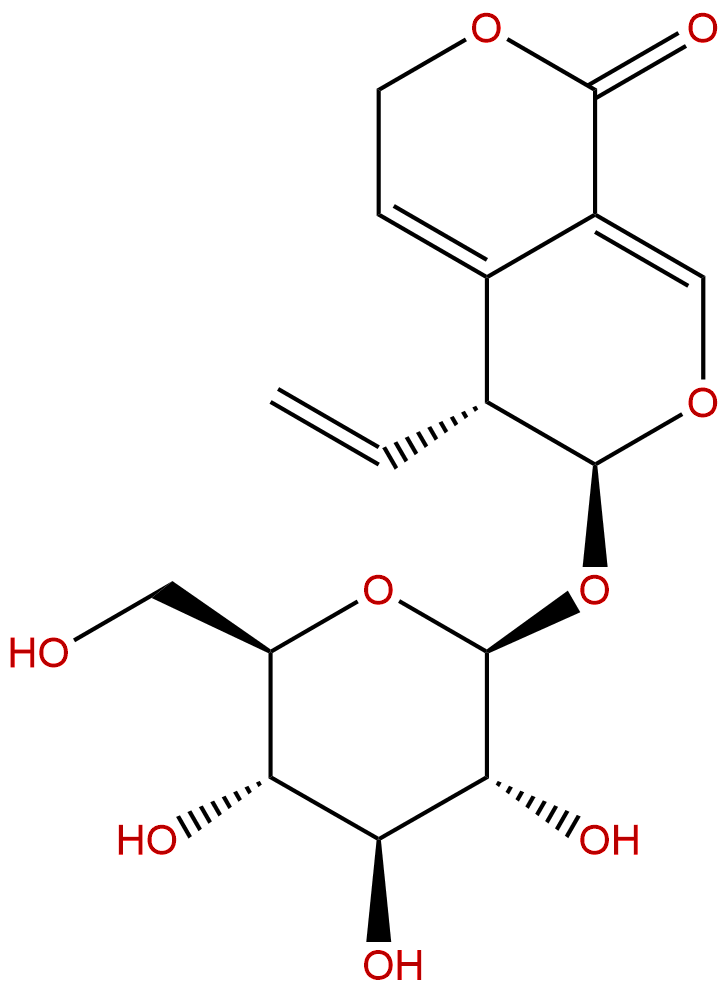
GentiopicrinCAS No.:20831-76-9
|
||||||||||
 |
|
|
||||||||

| Catalogue No.: | BP0638 |
| Formula: | C16H20O9 |
| Mol Weight: | 356.327 |
Synonym name:
Catalogue No.: BP0638
Cas No.: 20831-76-9
Formula: C16H20O9
Mol Weight: 356.327
Botanical Source: Widespread in the Gentianaceae, e.g. Swertia and Gentiana spp.
Purity: 95%~99%
Analysis Method: HPLC-DAD or/and HPLC-ELSD
Identification Method: Mass, NMR
Packing: Brown vial or HDPE plastic bottle
Can be supplied from milligrams to grams.
For Reference Standard and R&D, Not for Human Use Directly.
Inquire for bulk scale.
Description:
Gentiopicroside has been developed into a novel traditional Chinese drug named gentiopicroside injection, and it was approved for the treatment of acute jaundice and chronic active hepatitis by SFDA.Gentiopicroside has analgesic, smooth muscle relaxing, antibacterial, and free radical scavenging activities, it exerts anti-inflammatory effects on experimental acute colitis through attenuating the expression levels of TNF-α, IL-1β, IL-6, iNOS and COX-2.
References:
J Ethnopharmacol. 2015 Aug 22;172:100-7.
Gentiopicroside prevents interleukin-1 beta induced inflammation response in rat articular chondrocyte.
In traditional Chinese medicine, Gentiana macrophylla Pall have been prescribed for the treatment of pain and inflammatory conditions. In addition, it is a common Tibetan medicinal herb used for the treatment of tonsillitis, urticaria, and rheumatoid arthritis (RA), while the flowers of G. macrophylla Pall have been traditionally treated as an anti-inflammatory agent to clear heat in Mongolian medicine. The secoiridoid glycosides and their derivatives are the primary active components of G. macrophylla and have been demonstrated to be effective as anti-inflammatory agents.
METHODS AND RESULTS:
Solvent extraction and D101 macroporous resin columns were employed to concentratethe Gentiopicroside. Gentiopicroside cytotoxicity was assessed by 3-(4,5-Dimethylthiazol-2-yl)-2,5-diphenyltetrazolium bromide (MTT) assay; the toxicity of Gentiopicroside in chondrocytes was reconfirmed using Hoechst staining. Western blotting, reverse transcriptase-polymerase chain reaction (RT-PCR) and immunohistochemistry were utilized to explore the protective effects and mechanisms of Gentiopicroside prevents interleukin-1 beta induced inflammation response in rat articular chondrocyte. The MTT assay demonstrated that 50, 500, and 1,500 μg/mL of Gentiopicroside exhibited no significant toxicity to chondrocytes (P>0.05) after 24h. Using immunohistochemistry, ELISA, RT-PCR, Western blot method to explore the protective effect and mechanism of Gentiopicroside on chondrocytes induced by IL-1β. The results showed some pathways of IL-1β signal transduction were inhibited by Gentiopicroside in rat chondrocytes: p38, ERK and JNK. Meanwhile, Gentiopicroside showed inhibition in the IL-1β-induced release of MMPs while increasing Collagen type II expression.
CONCLUSIONS:
The current study demonstrated that Gentiopicroside exhibited a potent protective effect on IL-1β induced inflammation response in rat articular chondrocyte. Thus, Gentiopicroside could be a potential therapeutic strategy for treatment of OA.
Fitoterapia. 2003 Feb;74(1-2):151-4.
Bioactivity of gentiopicroside from the aerial parts of Centaurium erythraea.
Gentiopicroside (1), a secoiridoid glycoside isolated from the methanol extract of the aerial parts of Centaurium erythraea, has been assessed for antibacterial and free radical scavenging activities. General toxicity of 1 has also been determined by brine shrimp lethality bioassay.
Fitoterapia. 2015 Apr;102:127-33.
Effect of gentiopicroside on experimental acute pancreatitis induced by retrograde injection of sodium taurocholate into the biliopancreatic duct in rats.
Gentiopicroside (otherwise known as Gentiopicrin), one of the main active ingredients from the traditional Chinese herb medicine Gentiana manshurica Kitag, presents the effect of attenuating acute pancreatitis in rats.
METHODS AND RESULTS:
The experimental acute pancreatitis was made by retrograde injection of sodium taurocholate into the biliopancreatic duct in rats. Gentiopicroside was given orally and it markedly reduced the pancreatitis-evoked increase of serum amylase and lipase activity, decreased the pancreas mass/body mass index, tissue water content, TNF-α and IL-1β concentrations, and attenuated the histopathological changes and NF-κB p65 protein expression in pancreatic tissue.
CONCLUSIONS:
The results indicate that the function of Gentiopicroside on acute pancreatitis may be related to inhibiting the release of inflammatory mediators and NF-κB p65 protein expression.
Chinese Traditional & Herbal Drugs, 2003, 34(9):814-6
Studies on anti-inflammatory effect of gentiopicroside.
To study the anti-inflammatory effect of Gentiopicroside extracted from Radix Gentianae Marrophyllae.
METHODS AND RESULTS:
The models of auricular edema in mice induced by dimeth yl benzene, increased permeability of celiac blood capillary and body-twisting reaction induced by acetic acid, paw swelling induced by zymosan A, carrageenan a nd nystatin in rats or in mice were prepared. Then Gentiopicroside was given to the rats or mice by ig. Gentiopicroside inhibited th e auri cular edema, decreased the permeability of celiac blood capillary, reduced the p aw swelling induced by carrageenan and zymosan A, but not by nystation.
CONCLUSIONS:
Gentiopicroside extracted from Radix Gentianae Marrophyllae, exhibits obvious anti-inflammatory effects.
HPLC of Gentiopicrin
